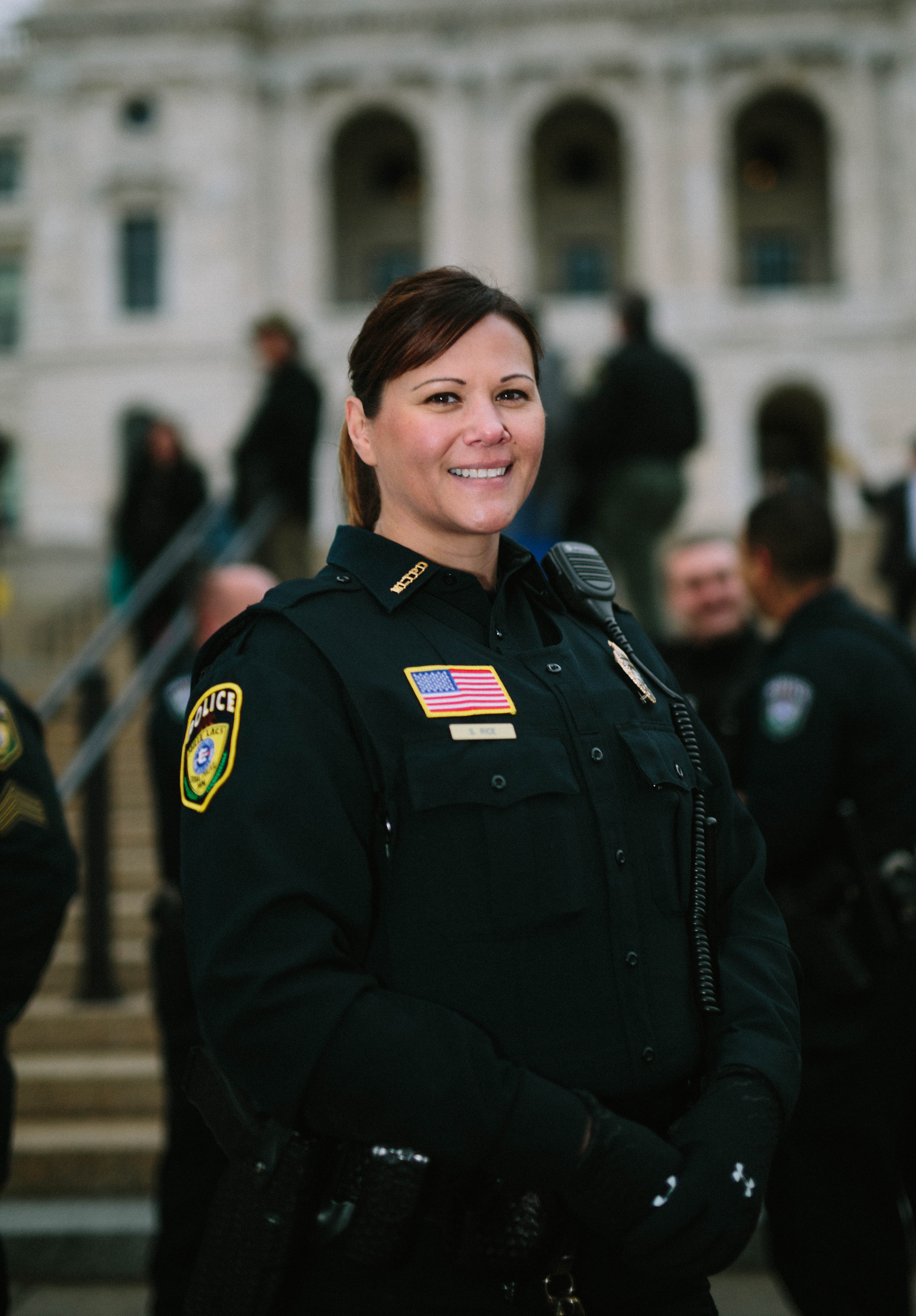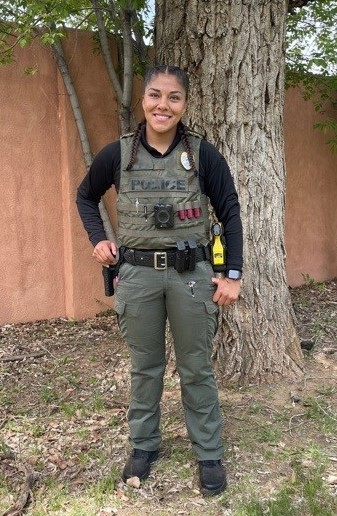Contact Us
To provide feedback on the Community Policing Dispatch, e-mail the editorial board at CPDispatch@usdoj.gov.
To obtain details on COPS Office programs, publications, and resources, contact the COPS Office Response Center at 800-421-6770 or AskCopsRC@usdoj.gov

U.S. Department of Justice
Office of Community Oriented Policing Services
Washington, DC 20530
Asked what prompted her to join tribal law enforcement, Sara Rice, chief of the Mille Lacs Band of Ojibwe Police Department in Northeast Minnesota, said “I have always had a passion for helping people.”
A similar response was given by Summer Mirabal, the recently appointed chief of the Taos Pueblo Department of Public Safety (TPDPS), who said she wanted to be a cop because she wanted to help people, especially those in her tribal community.
Though the desire to serve motivates law enforcement officers across the board, it’s an especially strong desire among female tribal police officers, who feel a deep, familial commitment to the people in their community.
For tribal women, putting that commitment to work in a law enforcement career is nothing new. As far back as 1905, when Julia Wades in the Water, a member of the Blackfeet Nation, began her 25 years of serving in Indian Country Law Enforcement, women have worked to make their people safe and the quality of their lives better.
Two Female Tribal Police Chiefs Are Making a Difference

Today, women serve in police departments throughout Indian Country, as patrol and corrections officers, detectives, and other roles, including leadership. Among them are Chiefs Rice and Mirabal.
In addition to leading a department of 21 officers and six staff members, Rice is the first Native American to sit on the Minnesota Board of Peace Officer Standards and Training (POST), which licenses more than 10,500 full-time and more than 250 part-time active peace officers in the state.
The moment Rice realized she wanted to be a cop came during a ride-along with a friend of her family. “It was exciting, and after reading a few reports of incidents that the officer had been involved in, I felt strongly that I wanted to help our people [by entering] a law enforcement career.”
She joined the force in 2001, rising through the ranks from patrol to investigative officer to conservation officer, in which role she enforced the statutes related to the netting and fishing, hunting, and gathering rights of the tribe, before becoming chief in 2018.

Mirabal, who supervises a staff of ten in a department serving the 3000 residents of the Taos Pueblo, which is outside the town of Taos, New Mexico, served in the military before starting her career as a cop. Because of this experience, she says she is comfortable working in a mostly male environment. Moreover, she learned from it that women can do anything men can do in a professional work environment.
Like Rice, she also speaks of devotion to her community. “These are my people,” she says,” and I know I can make a difference through my work.”
Female Officers Are More Likely to De-Escalate
Most importantly, women officers have proven to be better at defusing potentially violent confrontations with citizens before those encounters turn deadly. Various studies indicate that women are skilled in problem solving and de-escalation, and that they tend to use less force when making arrests.
Both Mirabal and Rice agree with that finding, saying that women tend to be more empathetic and therefor more likely to de-escalate situations by talking people down. Mirabal adds that in some cases, victims and suspects both request a female officer.
Says Rice, “We’ve had several women in elected and appointed positions in our tribe, and it brings in a different style of leadership. They are focused on solving problems and making changes for the better.”
This perception is shared by Kimberly Clark, a non-native who is the Public Safety Communications Manager of Arizona’s Salt River Pima-Maricopa Indian Community (SRPMIC).
Having worked in municipal police departments before joining SRPMIC, Clark was struck by the differences between tribal and non-tribal law enforcement, as well as by the widespread presence of women in tribal leadership positions.
“A lot of department heads are female, who, in my opinion, are more open and more communicative than many men I’ve worked with,” says Clark.
Clark believes that women are often nurturing as well. “Even if their role requires them to be an enforcer, they do it with a heart, slowing things down, and being more thoughtful in their approach,” she says.
Empathy and Insight Enhance Policing
Rice attributes this to the fact that many women in tribal law enforcement have experienced family issues. She also believes that women are more intuitive and empathetic, and can more readily see somebody’s pain, saying “I can spot an abusive relationship better than many men, for instance.”
Mirabal agrees. “I think most women have a motherly instinct and that brings another aspect to policing, especially when cases involve domestic violence or children. Women can bring a situation down from a 10 to a 3.”
But both feel that the challenges are greater for female leaders, sometimes especially so in Indian Country. “Some people aren’t accepting of your accomplishment or authority,” says Mirabal. “Women are respected in the tribe, but not as much in a leadership position. I think it’s difficult for many men to take direction from women.”
Though taking on an authoritative role can be challenging, women in tribal law enforcement are in a position to improve the quality of life in their communities.
“I believe that we can make a difference in our communities every day through police work,” says Mirabal. “If I arrest somebody who’s addicted to drugs or alcohol, for instance, it’s not to get them into trouble, but to get them help. This can be the first step in getting them to change. And if I get a drunk driver off the street, I can save somebody’s life.”
On a larger scale, the TPDPS is working on a new program to identify the causes of addiction in their community. “We will work with various wellness and recovery programs, the tribal council, and the courts to find solutions to the root causes of the problems people in our community have,” says Mirabal.
She is equally concerned about the well-being of members of her department. “One of my goals is to increase support for the mental and physical health and wellness of our officers, who often work overtime. We can’t protect our community if we aren’t okay too,” she notes.
Overcoming Career Challenges with the Help of Others
Asked how she would advise girls considering a future in law enforcement, Rice says “Find a strong woman to mentor you and provide support when you are frustrated, somebody who can help you through the struggles of law enforcement. It’s hard being a female officer, let alone being a native female cop,” she adds.
“I’ve been helped by strong women myself,” Rice says, adding that the chief executive of her tribe, Melanie Benjamin, mentored her.
A 2013 survey conducted by the National Association of Women Law Enforcement Executives (NAWLEE) found that only about 169 women were leading the more than 1,500 police departments, sheriff’s offices, and other law enforcement agencies across the United States that responded.
Through the mentoring and examples of Chiefs Rice and Mirabal, as well as the many other women now in leadership roles, that number has risen greatly and will continue to do so.
Faye. C. Elkins
Sr. Technical Writer
COPS Office
Subscribe to Email Updates
To sign up for monthly updates or to access your subscriber preferences, please enter your email address in the Subscribe box.






